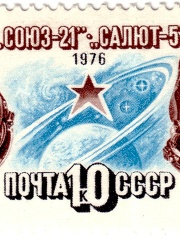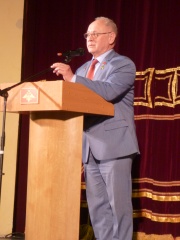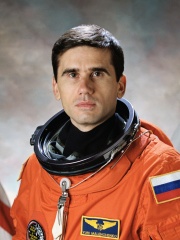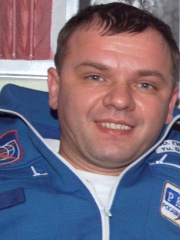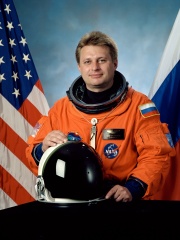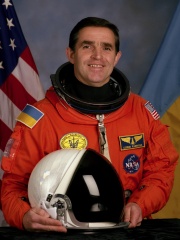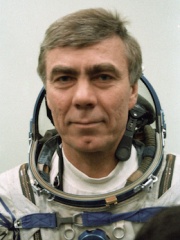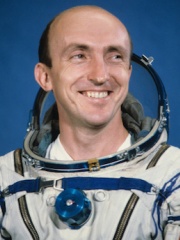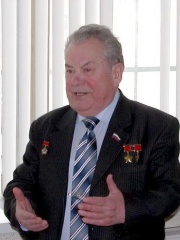
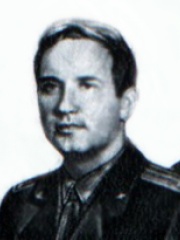
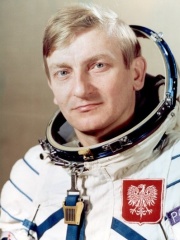
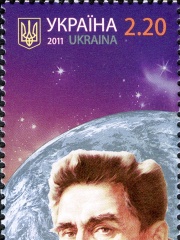
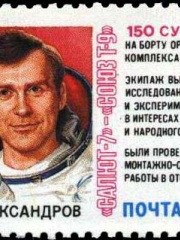
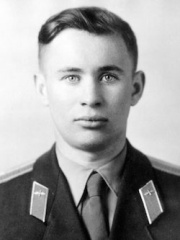
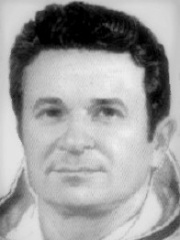
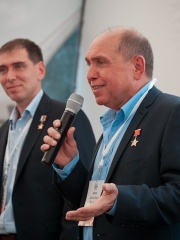
The Most Famous
ASTRONAUTS from Ukraine
This page contains a list of the greatest Ukrainian Astronauts. The pantheon dataset contains 556 Astronauts, 18 of which were born in Ukraine. This makes Ukraine the birth place of the 3rd most number of Astronauts behind United States, and Russia.
Top 10
The following people are considered by Pantheon to be the top 10 most legendary Ukrainian Astronauts of all time. This list of famous Ukrainian Astronauts is sorted by HPI (Historical Popularity Index), a metric that aggregates information on a biography's online popularity. Visit the rankings page to view the entire list of Ukrainian Astronauts.

1. Pavel Popovich (1930 - 2009)
With an HPI of 66.31, Pavel Popovich is the most famous Ukrainian Astronaut. His biography has been translated into 39 different languages on wikipedia.
Pavel Romanovich Popovich (Russian: Па́вел Рома́нович Попо́вич; Ukrainian: Павло́ Рома́нович Попо́вич, romanized: Pavló Románovych Popóvych; 5 October 1930 – 29 September 2009) was a Soviet cosmonaut. Popovich was the fourth cosmonaut in space, the sixth person in orbit, the eighth person and first Ukrainian in space.

2. Georgy Dobrovolsky (1928 - 1971)
With an HPI of 65.32, Georgy Dobrovolsky is the 2nd most famous Ukrainian Astronaut. His biography has been translated into 35 different languages.
Georgy Timofeyevich Dobrovolsky (Russian: Георгий Тимофеевич Добровольский; 1 June 1928 – 30 June 1971) was a Soviet cosmonaut who commanded the three-man crew of the Soyuz 11 spacecraft. They became the world's first space station crew aboard Salyut 1, but died of asphyxiation because of an accidentally opened valve. They were the first and only humans to have died in space.

3. Mirosław Hermaszewski (1941 - 2022)
With an HPI of 63.61, Mirosław Hermaszewski is the 3rd most famous Ukrainian Astronaut. His biography has been translated into 40 different languages.
Mirosław Hermaszewski (Polish: [miˈrɔswaf xɛrmaˈʂɛfski] ; 15 September 1941 – 12 December 2022) was a Polish cosmonaut, fighter plane pilot, and Polish Air Force officer. He became the first and, at the time of his death in December 2022, only Polish national to ever go to space when he flew aboard the Soviet Soyuz 30 spacecraft in 1978. He was the 89th human to reach outer space.

4. Georgy Beregovoy (1921 - 1995)
With an HPI of 62.61, Georgy Beregovoy is the 4th most famous Ukrainian Astronaut. His biography has been translated into 39 different languages.
Georgy Timofeyevich Beregovoy (Russian: Гео́ргий Тимофе́евич Берегово́й, Ukrainian: Гео́ргій Тимофі́йович Берегови́й; 15 April 1921 – 30 June 1995) was a Soviet cosmonaut who commanded the space mission Soyuz 3 in 1968. From 1972 to 1987, he headed the Yuri Gagarin Cosmonaut Training Center. At the time of his space flight, Beregovoy was 47 years of age: he was the earliest-born human to go to orbit, being born three months and three days earlier than the second earliest-born man in orbit – John Glenn, but later than X-15 pilot Joe Walker who made 2 (or 3, according to USAF definition) suborbital space flights.
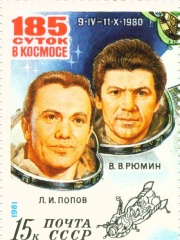
5. Leonid Popov (b. 1945)
With an HPI of 62.15, Leonid Popov is the 5th most famous Ukrainian Astronaut. His biography has been translated into 28 different languages.
Leonid Ivanovich Popov (Russian: Леони́д Ива́нович Попо́в, Ukrainian: Леонід Іванович Попо́в; born August 31, 1945) is a former Soviet cosmonaut.

6. Vladimir Lyakhov (1941 - 2018)
With an HPI of 61.53, Vladimir Lyakhov is the 6th most famous Ukrainian Astronaut. His biography has been translated into 29 different languages.
Vladimir Afanasyevich Lyakhov (Ukrainian: Володимир Афана́сійович Ляхов; Russian: Влади́мир Афана́сьевич Ля́хов; 20 July 1941 – 19 April 2018) was a Ukrainian Soviet cosmonaut. He was selected as cosmonaut on 5 May 1967, and retired on 7 September 1994. Lyakhov was the Commander on Soyuz 32, Soyuz T-9, and Soyuz TM-6, and spent 333 days, 7 hours, 47 minutes in space. He was married and had two children. Lyakhov's flight to Salyut-6 with Valeri Ryumin as the Soyuz 32 crew resulted in setting a space endurance record of 175 days when they returned to Earth on 19 August 1979. Lyakhov conducted three spacewalks for a cumulative total of 7 hours and 8 minutes with one outside of Salyut 6 and two outside of Salyut 7. Lyakhov was deputy director for cosmonaut training and deputy commander of the cosmonaut corps at the Gagarin Cosmonaut Training Center. He retired in 1994. He was twice awarded the Order of Lenin and was twice named a Hero of the Soviet Union. He was also named a Hero of the Democratic Republic of Afghanistan and awarded with the Order of the Saur Revolution and Order of The Sun of Freedom.

7. Valentin Bondarenko (1937 - 1961)
With an HPI of 61.24, Valentin Bondarenko is the 7th most famous Ukrainian Astronaut. His biography has been translated into 23 different languages.
Valentin Vasilyevich Bondarenko (Russian: Валентин Васильевич Бондаренко; Ukrainian: Валентин Васильович Бондаренко; 16 February 1937 – 23 March 1961) was a Soviet fighter pilot selected in 1960 for training as a cosmonaut. He died as the result of burns sustained in a fire during a 15-day low-pressure endurance experiment in Moscow. The Soviet government concealed the death, along with Bondarenko's membership in the cosmonaut corps, until 1980. A crater on the Moon's far side is named after him.

8. Leonid Kizim (1941 - 2010)
With an HPI of 60.51, Leonid Kizim is the 8th most famous Ukrainian Astronaut. His biography has been translated into 30 different languages.
Leonid Denisovich Kizim (Russian: Леонид Денисович Кизим; 5 August 1941 – 14 June 2010) was a Soviet cosmonaut.

9. Aleksandr Aleksandrovich Volkov (b. 1948)
With an HPI of 59.91, Aleksandr Aleksandrovich Volkov is the 9th most famous Ukrainian Astronaut. His biography has been translated into 26 different languages.
Aleksandr Aleksandrovich Volkov (Russian: Алекса́ндр Алекса́ндрович Во́лков; born 27 May 1948) is a retired Soviet cosmonaut. He is a veteran of 3 space flights, including twice to the Mir Soviet space station, and is the father of cosmonaut Sergey Volkov.
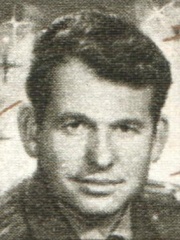
10. Georgy Shonin (1935 - 1997)
With an HPI of 59.70, Georgy Shonin is the 10th most famous Ukrainian Astronaut. His biography has been translated into 29 different languages.
Georgy Stepanovich Shonin (Ukrainian: Гео́ргій Степа́нович Шо́нін; 3 August 1935 – 7 April 1997) was a Soviet cosmonaut, who flew on the Soyuz 6 space mission. Shonin was born in Rovenky, Luhansk Oblast, (now Ukraine) but grew up in Balta in the Ukrainian SSR. His family hid a Jewish family from the Nazis during WWII. In February 1957, Shonin graduated Naval Aviation School as was awarded his lieutenant's wings. He was then posted to the 935th Fighter Regiment of the Baltic Fleet which was the naval element of the Soviet Air Force. In 1958, he was transferred to the 768th Fighter Regiment of the Northern Fleet based in the Murmansk region. During this time, he would befriend another young flying officer named Yuri Gagarin. Shonin was part of the original group of cosmonauts selected in 1960. Shonin would fly on Soyuz 6 in October 1969. He left the space program in 1979 for medical reasons. He was then promoted to major general. Shonin later worked as the director of the 30th Central Scientific Research Institute, Ministry of Defence (Russia) where he had management responsibilities for the development of the Buran space shuttle. He died of a heart attack in 1997.
People
Pantheon has 18 people classified as Ukrainian astronauts born between 1921 and 1962. Of these 18, 7 (38.89%) of them are still alive today. The most famous living Ukrainian astronauts include Leonid Popov, Aleksandr Aleksandrovich Volkov, and Vitaly Zholobov. The most famous deceased Ukrainian astronauts include Pavel Popovich, Georgy Dobrovolsky, and Mirosław Hermaszewski.
Living Ukrainian Astronauts
Go to all RankingsLeonid Popov
1945 - Present
HPI: 62.15
Aleksandr Aleksandrovich Volkov
1948 - Present
HPI: 59.91
Vitaly Zholobov
1937 - Present
HPI: 58.36
Anatoly Artsebarsky
1956 - Present
HPI: 56.51
Yuri Malenchenko
1961 - Present
HPI: 56.18
Yuri Gidzenko
1962 - Present
HPI: 54.44
Yury Onufriyenko
1961 - Present
HPI: 53.25
Deceased Ukrainian Astronauts
Go to all RankingsPavel Popovich
1930 - 2009
HPI: 66.31
Georgy Dobrovolsky
1928 - 1971
HPI: 65.32
Mirosław Hermaszewski
1941 - 2022
HPI: 63.61
Georgy Beregovoy
1921 - 1995
HPI: 62.61
Vladimir Lyakhov
1941 - 2018
HPI: 61.53
Valentin Bondarenko
1937 - 1961
HPI: 61.24
Leonid Kizim
1941 - 2010
HPI: 60.51
Georgy Shonin
1935 - 1997
HPI: 59.70
Leonid Kadeniuk
1951 - 2018
HPI: 57.94
Anatoly Levchenko
1941 - 1988
HPI: 56.64
Vladimir Vasyutin
1952 - 2002
HPI: 53.48
Overlapping Lives
Which Astronauts were alive at the same time? This visualization shows the lifespans of the 10 most globally memorable Astronauts since 1700.

